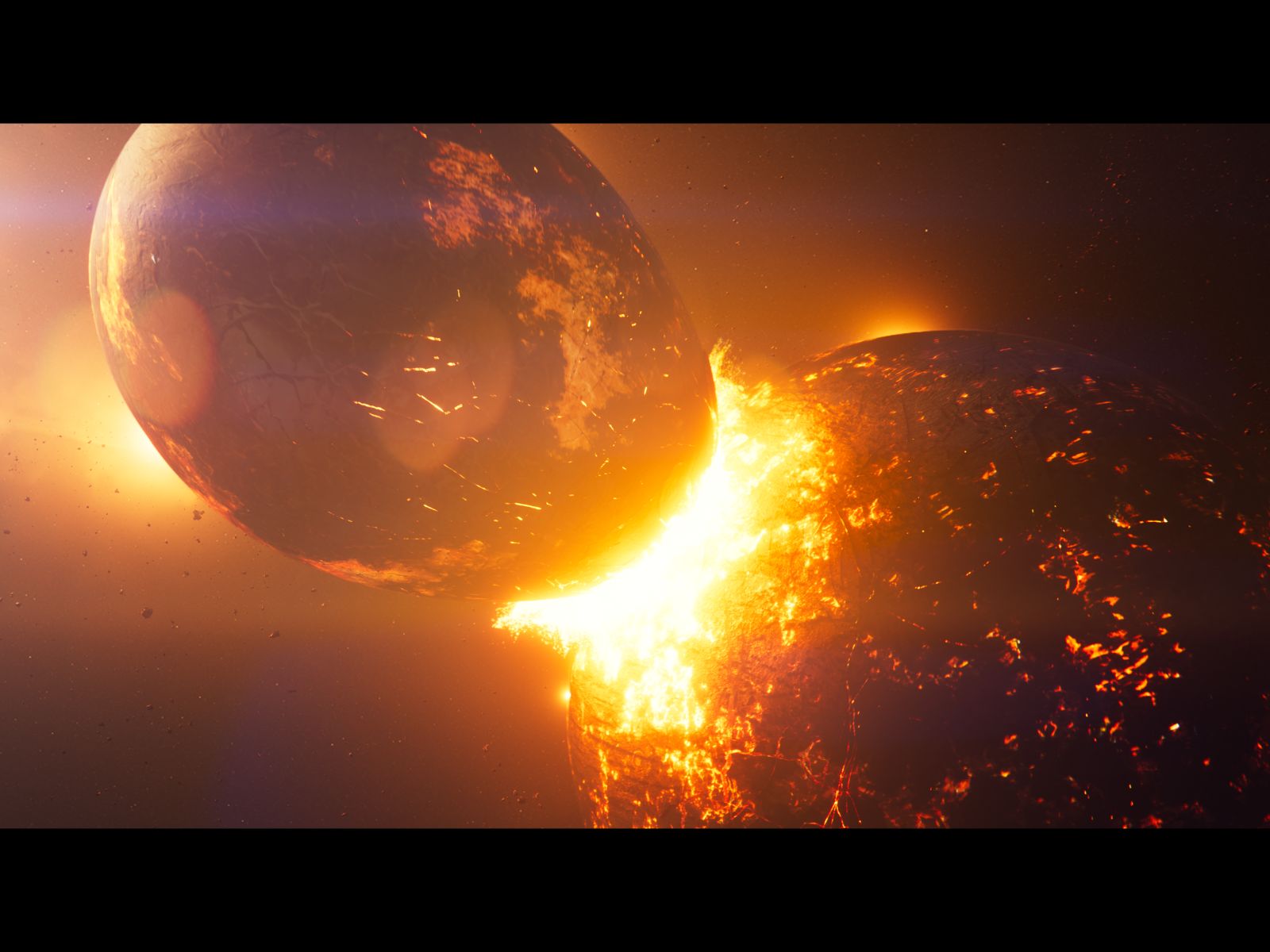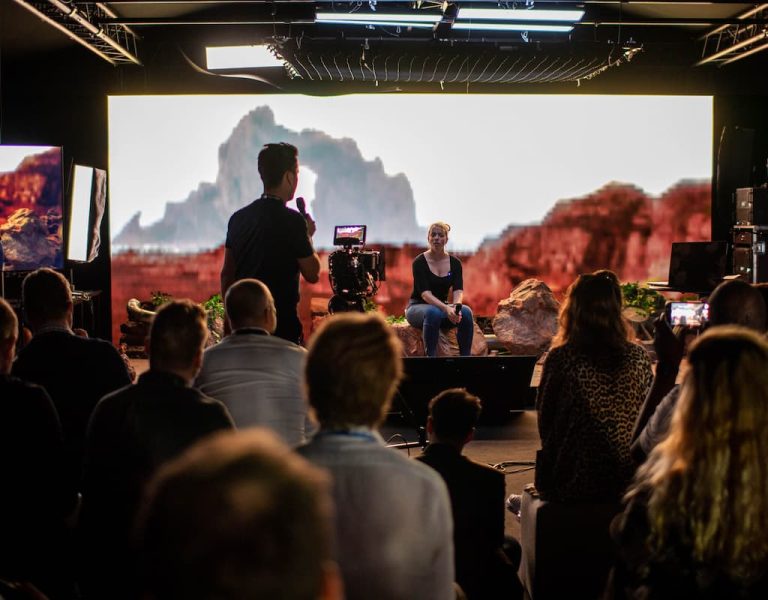
In a project spanning two years, Lux Aeterna delivered all VFX for Our Universe, a new landmark series from Netflix. Created by the BAFTA and Emmy Award-winning BBC Studios Science Unit, directed by Naomi Austin, Stephen Cooter, and Alice Jones, and narrated by Hollywood actor Morgan Freeman, the show is a blend of cosmological science and natural history. The series takes viewers on a fascinating journey to discover how all the ingredients of life ended up on Earth.
From the Big Bang to rogue asteroids and galactic collisions, Lux Aeterna needed to create a mind-bending visual grammar to convey complex scientific concepts in a cinematic way. First pitched in November 2020, the project involved 18 months of VFX work to produce more than 700 shots for the six-part series. While most of the work involved bringing cosmic phenomena to the screen, the company also fine-tuned some real-world wildlife footage.
Lux Aeterna completed the project on time with a team of around 25 VFX artists, the majority of which are based at the team’s studio in the UK city of Bristol, a thriving creative hub.
Among the most challenging sequences that Lux Aeterna put together were those that involved invisible forces, such as solar winds and Earth’s magnetic field. “There’s always a challenge in creating shots of things you can’t actually see,” says Paul Silcox, VFX Director at Lux Aeterna and VFX Supervisor on Our Universe. “A lot of these stories have been told before, but what we had to do was find new ways to show them with a compelling narrative, while maintaining a cinematic aesthetic. It’s all about giving the artists the creative freedom to deliver the brief.”
As one of three directors on the project, each looking after two episodes apiece, Emmy and Grierson Award-winning filmmaker Stephen Cooter was heavily involved in developing the overall look of the show. “We knew that it wasn’t a standard space or wildlife documentary and that we needed to tie together those two elements with a cinematic look, centered around the animals as ‘lead characters’,” says Stephen. “We decided early on that we wanted to shoot the whole show in a widescreen 2.39:1 ratio. Our go-to setup was Atlas Orion series anamorphic lenses, with a RED Gemini camera, while Panavision G Series anamorphic lenses were also used to capture the close-ups of turtles hatching. The anamorphic lenses enabled us to tie together the two strands of the show, as we were able to replicate the anamorphic flares that appeared in the natural history shots, in the VFX sequences.”

With the strategic use of lens flare giving a nod to the trademarks of movie directors Steven Spielberg and J.J. Abrams, whose work inspired the cinematic aesthetics of Our Universe, the show also featured a virtual production shoot with a live bear.
To complement the shots captured on location in Alaska, a studio shoot in Hungary was set up to capture the bear settling down to hibernate in response to the planet’s yearly journey through space. These moments of connection between animal and universe were crucial to the series storytelling, but difficult and potentially dangerous to shoot in the wild, so an innovative new approach was required. A young male European brown bear called Koda was provided by professional animal training firm Horkai which worked in tandem with a UK-based animal consultant to ensure that Koda was well cared for and best practice followed throughout the shoot.
A bear cave was constructed by set builders BK Filmstudio and the shots were captured using a technocrane against an LED screen backdrop showing the mountain backdrop. “Getting the camera so close to the bear and being able to move and drift it on the crane added so much to the shots,” says Stephen. “DoP Paul O’Callaghan chose to shoot with the Sony Venice because its high base ISO was perfect for shooting in the low light conditions we needed within the cave for the bear to fall asleep. To achieve the series look we paired the Venice with vintage Hawk anamorphic primes and a Cooke anamorphic zoom.”

Storytelling with real-world space data
In addition to innovative cinematography, the show also relied on ground-breaking VFX to tell the story. For one particular sequence, the team used real-world data to show the formation of Earth’s moon. The prevailing theory is that the Moon was formed from the debris resulting from Earth’s collision with a massive Mars-sized object known as Theia. To recreate this pivotal event on screen, the team used simulation data from Dr Jacob Kegerris, a postdoctoral researcher at Durham University’s Institute for Computational Cosmology (ICC). Jacob is currently based at NASA’s Ames Research Centre in Silicon Valley where he carries out pioneering research into planetary collisions.
Using Jacob’s simulations, the data for which was processed by Durham University’s COSMA supercomputer, the Lux Aeterna team was able to create a photo-realistic and cinematic scene. In fact, the finished sequence produced a surprise in the form of a short-lived second moon that formed out of the collision. As a result, the team added a new shot to show the reabsorption of this second moon. Jacob’s simulations, which have since been published, are helping to shed new light on the moon’s origins, suggesting that the Moon may have formed in a matter of hours, rather than over several months as previously thought.

Building a next-gen VFX pipeline
Bringing such a large amount of real-world data into the VFX pipeline was a significant challenge. It took four weeks to process a staggering 30TB of data into the various formats needed to create the shots. With over 100 million points per frame, 1.4 trillion data points were processed for the show. “There was so much data, which was challenging from a production point of view,” says Lux Aeterna’s Paul Silcox. “We had to change quite a few things about the way we work to manage that data pipeline.”
While Lux Aeterna has its own on-site rendering capabilities, it also turned to the cloud to scale up its rendering output using AWS for this project. Working predominantly in Houdini, along with Maya and Nuke, the team also developed a number of in-house tools to deal with specific challenges. What’s more, ShotGrid project management software was added to the pipeline and is now used on all of the studio’s projects.
As a result, Lux Aeterna is now well placed to take on more projects of this scale and beyond. “We’re building a robust and powerful pipeline so that we can expand on what we put in place for Our Universe, and work on even larger projects in future,” says Paul.
Working as a creative partner on Our Universe, Lux Aeterna collaborated closely with BBC Studios throughout the project, with shots being reviewed daily. “We pride ourselves on building close relationships with clients, and with directors and producers, from an early stage,” says Paul. “We’re there to help them to realise their vision, and bring a compelling story to the screen with cutting edge visuals. The support and encouragement we had from both Netflix and BBC Studios was instrumental in us successfully delivering the VFX for Our Universe.”

Mike Davis, Executive Producer at BBC Studios Natural History Unit and Our Universe Showrunner says: “From their incredibly imaginative pitch for the job through to their commitment to delivering finals of the highest standard, Lux Aeterna have been a wonderful creative partner on the Our Universe series.
“Netflix and BBC Studios rightly set the bar very high for this ambitious new series that connects major events in the universe’s history with the survival of six iconic animals on our planet today. A level of cinematic photorealism was required, not just in depicting key moments in the history of the cosmos, but also on radically different scales from cellular down to molecular and even sub-atomic. Each of these required their own distinctive look, whilst needing to feel unified and in harmony with the rest of the series.
“Lux Aeterna’s mastery of Houdini for all our environments and atmospheres, and the team’s ability to crunch down massive, complex simulations from scientists into gorgeous, accessible sequences, made this series feel truly special and distinct. Their communication throughout production, flair in visual storytelling and willingness to experiment make them a company I’d be very happy to recommend and look forward to working with again.”












